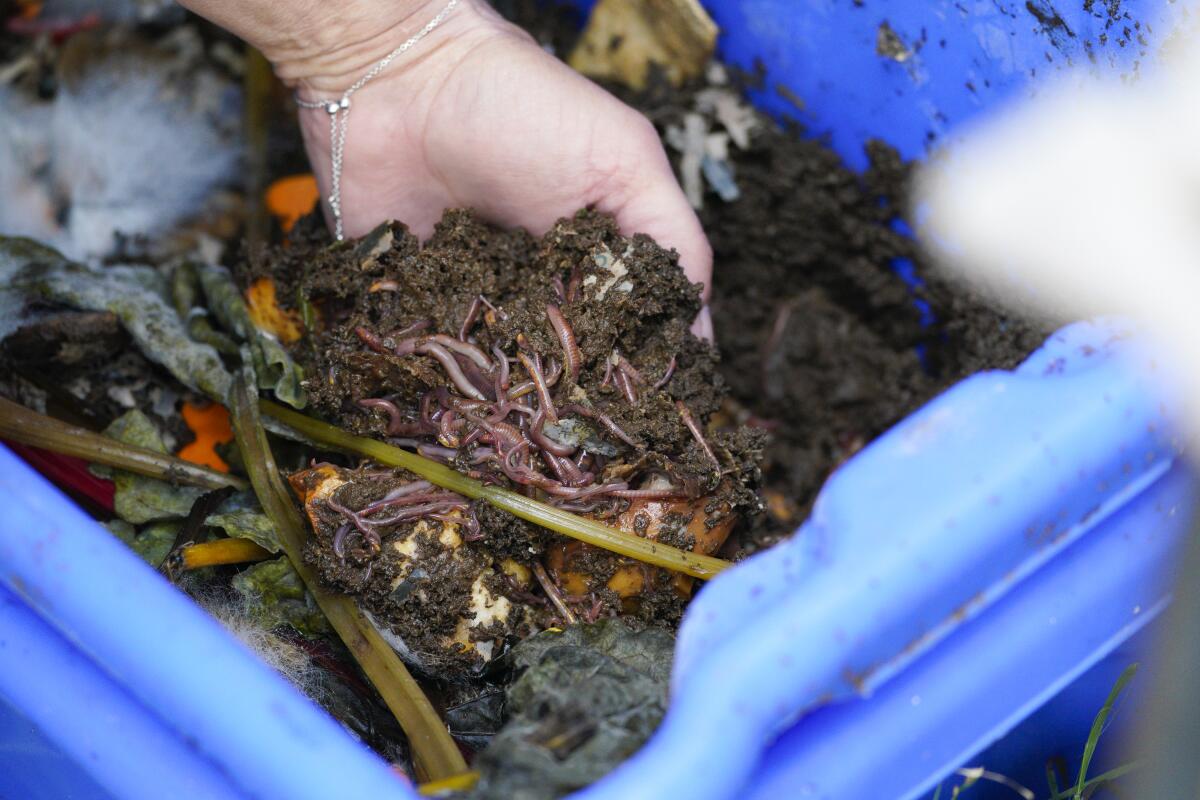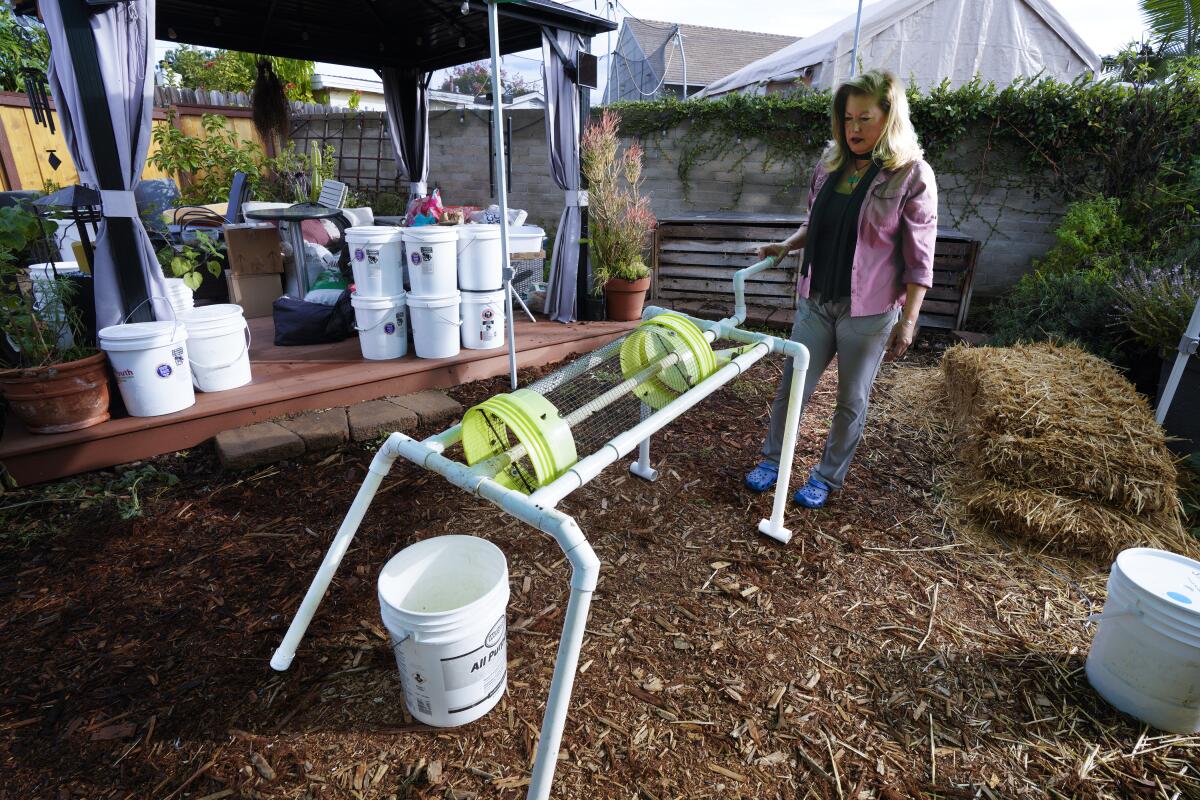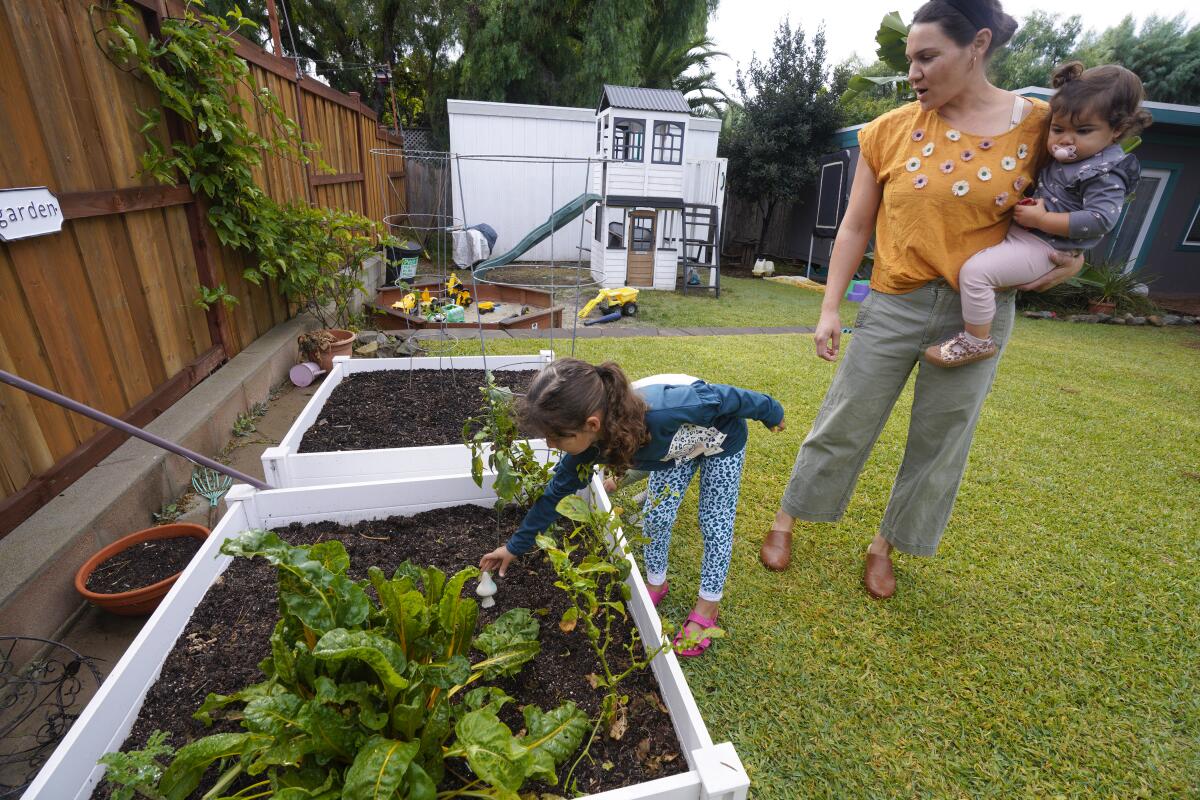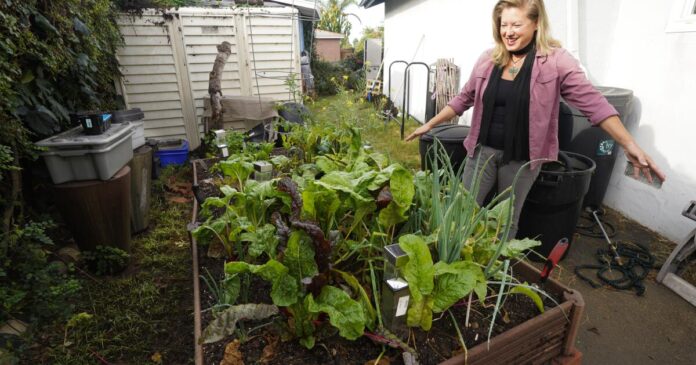It’s a common sight most days to see people walking up to the blue house at the end of a Chula Vista cul-de-sac carrying a container filled with food scraps. They then empty those scraps into one of the white buckets beside a sign that reads “Food Scrap Collection Site” for South Bay Sustainable Communities, a local nonprofit that’s big on community outreach.
The house belongs to SBSC founder and executive director Tina Matthias and her husband, Eric Bonney, the organization’s co-founder and lead master composter. Since 2019, she has run this composting program along with several others under SBSC, including Youth 4 A Sustainable Future, community cleanups, nature hikes, and gardening and zero-waste workshops.
Matthias, who worked at the Living Coast Discovery Center in Chula Vista for more than 32 years as volunteer and programs manager until her retirement, is also a member of the City of Chula Vista Sustainability Commission. She was interested in jump-starting zero-waste programs in light of the 2016 passage of California’s Senate Bill 1383, which required every jurisdiction in the state to provide organic-waste collection services to all residents and businesses as of 2022.

Matthias lets her compost bin reach 130 degrees before turning it.
(Nelvin C. Cepeda / The San Diego Union-Tribune)

Worms process the food scraps into nutrient-rich castings, which can be used for gardening or to spread around landscape plants.
(Nelvin C. Cepeda / The San Diego Union-Tribune)
Matthias held several zero-waste outreach events but realized she needed to get her own Chula Vista community engaged. When COVID hit and the lockdown prevented her from going to her job, she decided it was the perfect opportunity to start her neighborhood composting vision.
After doing some research with organizations in Northern California to learn best practices, her own street became ground zero, a pilot program with Matthias and Bonney doing the composting. The program now numbers 16 neighborhoods.
Matthias started by developing handouts for her neighbors. One explained the need for residents to reduce their carbon footprint and ways that SBSC could help them make sustainable and eco-minded choices. A second one was a “pledge” for neighbors to take to adopt zero-waste practices in areas such as energy, food, water, transportation and waste. A third described composting basics — what to compost and what not to compost.

Tina Matthias demonstrates the use of a sifter that separates larger pieces from more processed compost. The neighborhood operation produces a new batch of compost every 45 to 60 days.
(Nelvin C. Cepeda / The San Diego Union-Tribune)
“I started walking down the street with pamphlets and little goodies from the city of Chula Vista, along with Tupperware-type containers, and gave them to the neighbors,” she recalled. “I’d literally sit down and talk to them about the program.”
Matthias recruited more than a dozen participants on her street and, even with everyone now having city-furnished green waste bins, they’re still engaged. The reasons make practical sense.

Matthias’ cherry tomatoes and other backyard vegetables have benefited from the nutrient-rich mixture.
(Nelvin C. Cepeda / The San Diego Union-Tribune)
“To keep from getting fruit flies in your little city-provided caddies, you need to store the food waste in the refrigerator or freezer before dumping it in the green waste bin before the city’s weekly pickup, especially in the summer,” she pointed out. “That takes up a lot of space. People sometimes feel they have to throw it away, but they want to do good and not throw it in the trash.
“Plus, not everyone has greens from their garden to put in their green bin, and putting just food waste in it means you have to wash the bin. So, how much easier would it be to just put meats and bones and dairy waste in the fridge and drop off your green waste down the street whenever you want?”

Matthias shows her compost bin in the garden of her Chula Vista home.
(Nelvin C. Cepeda / The San Diego Union-Tribune)
Plus, Matthias notes, neighborhood participants have access to the compost their food waste helps create. Once a batch of compost is ready, the couple emails participants so they can stop by and pick some up.

Pia Coleman, a participant in the neighborhood composting program, and three of her kids — Luciana, Coleman and Pia — bring their food scraps to Matthias’ house.
(Nelvin C. Cepeda/The San Diego Union-Tribune)
And, it’s free because as part of SBSC, the neighborhood composting program is part of a larger organization that’s already funded.
Matthias also pointed out the reality that a lot of people who try composting on their own don’t produce enough food waste to get a substantial amount of compost. By inviting neighbors to add theirs, everyone can benefit from a larger haul.
But there are also less tangible reasons to participate in a neighborhood composting program: becoming part of a connected community.
“We got to know everyone on the street,” said Matthias. “Now we share recipes, we share food, we help people grow stuff, and if they’re growing one thing, we’ll be growing another, and then there’s a swap.”

Food scraps are collected in buckets. Nearby tools help neighbors shovel the compost to take home.
(Nelvin C. Cepeda / The San Diego Union-Tribune)
Dawn Waibel lives around the corner from Matthias and Bonney. She rents her house, so she wasn’t interested in making an investment in composting, plus she’s aware that she can’t produce enough on her own to make it worthwhile. But she has a container garden and met Matthias through one of her programs, so she’s become one of the neighborhood composting participants.
“I’ve met a lot of different people and made new friends,” Waibel said. “I don’t eat meat or dairy, but I process so many vegetables my compost bucket is usually at least half full or full every week. I love that I have an easy way of taking care of it and it’s also more environmentally friendly.”
Pia Coleman lives a few houses down the street from Matthias and Bonney with her husband and their five children. Two are in high school. The younger ones are ages 6, 3 and 1. Coleman keeps a garden that the little ones help with. Six-year-old Luciana often carries a container of the family’s scraps to the drop-off with her siblings and mom.

After dropping off their food scraps at the collection site, Pia Coleman and her children walk back to their home.
(Nelvin C. Cepeda/The San Diego Union-Tribune)
Over the summer, Coleman grew zucchini, lettuce, kale, tomatoes and bell and jalapeño peppers. Compost from the program enriched their growth. By participating, she’s gotten to know Matthias, and received gardening advice from her.
“I remember she was walking door to door and that’s how I realized she was my neighbor,” Coleman said. “I was just starting to get into regenerative gardening. She got me at a time when I was all in, and she’s taught me a lot.”
As for the green waste bin, Coleman said her family only uses it for cleaning up the yard.

Pia Coleman and her family use the compost in their own backyard garden.
(Nelvin C. Cepeda / The San Diego Union-Tribune)
Matthias offers the following suggestions for San Diego County residents who live outside of Chula Vista who want to start their own neighborhood composting program:
- Get information from your city about best practices and learn whether there are any programs for rebates or funding.
- Work with your waste hauler.
- Matthias learned in setting up and later expanding her program that people like benefits, such as caddies or metal straws. When recruiting your neighbors, she advises, bring them a caddy and compost to get them interested.
- Create and bring a handout that explains what your plan is, how they can participate, what the goals are, and instructions.
“What’s so beautiful about this composting program is the community you create,” said Coleman. “I feel like this really wrapped up our whole neighborhood. If somebody’s walking down the street now, you start talking with them. I feel like it made our street cozy since we all know each other. It’s so fun to be a part of something.”
Start a neighborhood composting program
There are several resources for learning how to compost, and it can extend to including your street or neighborhood.
- Check out the Solana Center for Environmental Innovation, in Encinitas, a nonprofit that focuses on soil, water and waste diversion. Their resources page (solanacenter.org/resources) includes a “Compost It Yourself Guide” that explains how to build a backyard bin, where to find supplies, where to find compost bin discounts and vouchers, and the basics of how to compost. They’re also very helpful, knowledgeable people, so don’t be shy about reaching out for advice.
- Finally, as Matthias advised, contact both your city and waster hauler for best practices information — and ask if they have any handouts that might get neighbors enthused while you’re recruiting.
Golden is a San Diego freelance writer and blogger.



